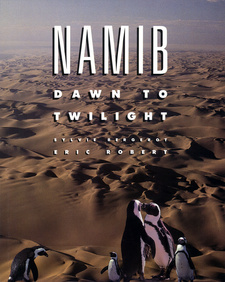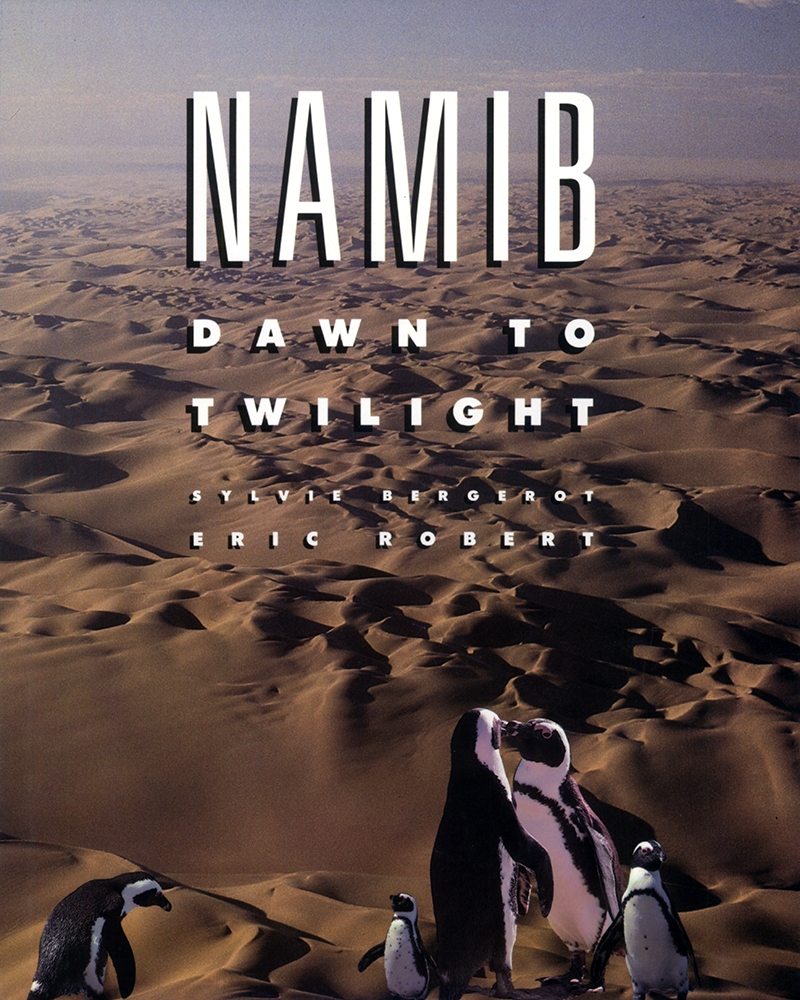Namib - Dawn to Twilight, by Eric Robert

Namib - Dawn to Twilight, by Eric Robert. Southern Book Publishers. Johannesburg, South Africa 1989. ISBN 1868122700 / ISBN 1-86-812270-0 / ISBN 9781868122707 / ISBN 978-1-86-812270-7
Namib - Dawn to Twilight is a beautiful country picture book by Eric Robert.
The Namib desert extends along the southwest coast of Africa in a high pressure zone generated by Hadley's cells. The desert covers a coastal area of approximately 1.900 km long between the Olifants River mouth in the Cape Province of South Africa and the district of Namibe (originally Mocamedcs) in southern Angola. It is crossed by two perennial rivers, the Kunene and the Orange River, which mark the northern and southern borders of Namibia. To the south of the Orange River, the desert is usually less than 50 km wide; in Namibia, along the 1.400 km between the Orange and the Kunene Rivers, the Namib, stretching to the Great Escarpment to the east, reaches an altitude of about 1.000 m and a maximum width of 200 km. This central part of the desert is the most arid. This region has a great landscape diversity: Immense gravel plains (hamada), dune fields, sand seas, inselbergs, chains of rocky hills, massive mountains to the east, salt flats, dry river beds, as well as the mouths of two permanent rivers which constitute the only oases in this endless aridity.
The Benguela System
Above the Atlantic Ocean there exists a permanent anticyclone at 30'S in summer and 26°S in winter. This anticyclone causes southerly winds along the coast of the Namib Desert. The wind generates surface currents; as a consequence of the relatively stable meteorological conditions, a surface current flows NNW up the Namib coast. It is not a fast current, flowing between 6 and 30 m per hour. Yet this current is but one aspect of the Benguela "system" which is also characterized by powerful "upwellings". This welling up of deep, cold ocean water to the surface significantly lowers the surface temperature along the coast. As a result, surface temperature is between 5°C and 8°C lower than water temperature at the same latitude further offshore, and temperatures of 12°C to 13°C are not rare at the Tropic of Capircorn. The presence of this mass of cold water profoundly influences the climate of the Namib Desert, resulting in moderate temperatures along the coast and limited rainfall. Temperature inversion at lower atmospheric levels is also a consequence of the cold water, creates favourable conditions for the formation of fog which fills the important ecological function of providing the main source of moisture for most species of plants and animals along the coast.
Climate
The Namib is a rather temperate desert. Temperatures above 40°C in the shade are rare and the annual average maximum temperatures is about 30°C; 12°C to 15°C the average minimum. As a result of sunshine, temperatures at ground level frequently exceed 60°C and at times 70°C. Temperatures can drop below 0°C by the end of the night in the central part of the desert. These drastic differences in ambient temperature render life particularly difficult for both plants and animals. The Namib is very arid. The least dry area, the foot of the Great Escarpment to the east, receives an annual rainfall of only about 100 mm. Precipitation progressively diminishes across the width of the Namib from east to west and along the coast the average does not exceed 12 to 15 mm. [...]
This is an excerpt from Namib - Dawn to Twilight, by Eric Robert.
Title: Namib
Subtitle: Dawn to Twilight
Author: Eric Robert
Publisher: Southern Book Publishers
Johannesburg, South Africa 1989
ISBN 1868122700 / ISBN 1-86-812270-0
ISBN 9781868122707 / ISBN 978-1-86-812270-7
Hardcover, dustjacket, 23 x 30 cm, 158 pages, throughout color photos
Robert, Eric im Namibiana-Buchangebot
Namib - Dawn to Twilight
The outstanding photographs perfectly reflect the exquisite beauty of western Namibia

